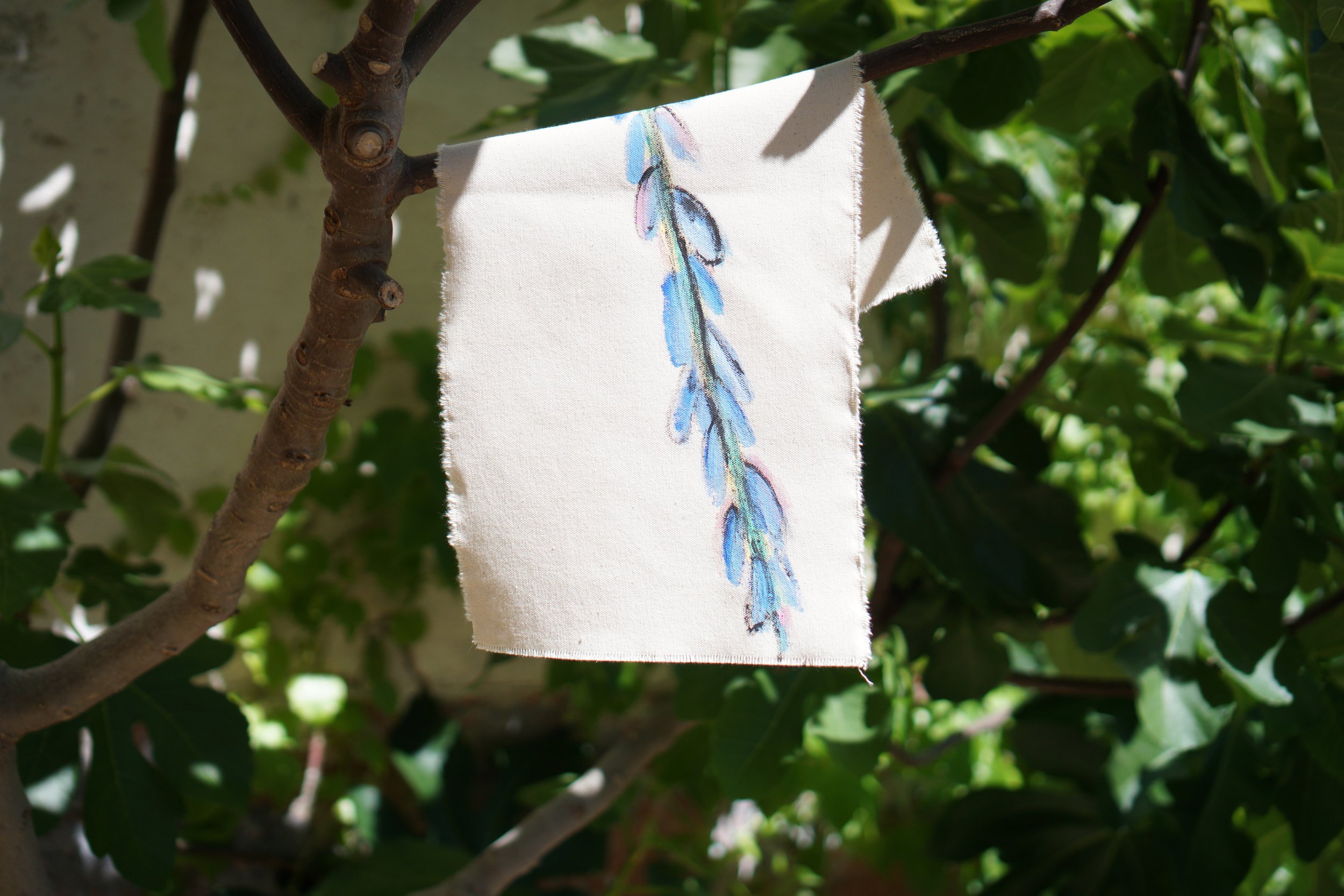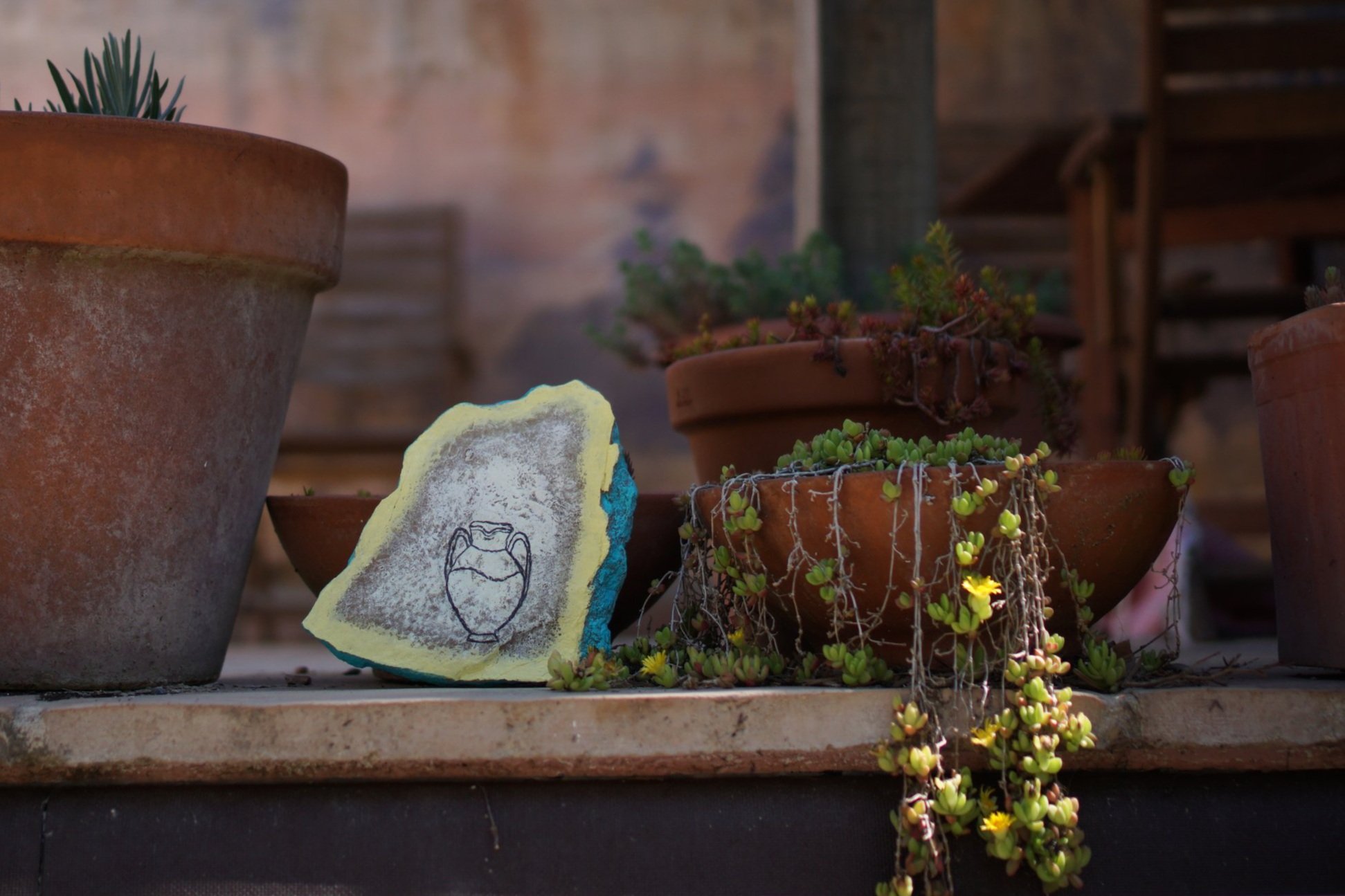Raquel Figueira
Raquel Figueira is a visual artist originally from Lisbon. She spent two weeks in residency at Cel del Nord in the summer of 2022 before returning to her home in London to embark on an MA in Sociology, studying alongside her established painting and drawing practice. To find out more about Raquel and her work visit her website raquelfigueira.com
Raquel in the studio at Cel del Nord
How did you surprise yourself in the two weeks that you spent at the residency?
Being in a rural environment without the visual overload of the city made a huge difference. I started noticing symbols, icons, marks everywhere, carved into buildings, above doors, windows, or on the ground. In Oristà, each house is tattooed with the date it was built in. You can touch and step on a tombstone engraved with a drawing from 1600 that’s just casually sitting under a tree. So there is a time/space compression, where a relic from the past is in the fabric of the present, being lived in and part of the now. This made me think about the intrinsic relationship between painting and architecture, how they used to be inseparable. Images were first painted on the walls and ceilings of caves, they were part of the place rather than placed in it. Going back to this ancient idea of painting was a surprise to me.
You turned that idea on its head too, and painted on parts of the residency building that had crumbled off. You elevated fragments that might have been discarded to treasured parts of the building. Has that followed you back to the studio? Have you been looking at your own space with new eyes?
Yes, I think it has made me want to work in a more transient and site-specific way. During the residency I found the dialogue between the work and the house, village, and landscape quite fluid. I did a lot of wandering around, so part of the process was being on the move. As a result of that, the work I’m making has become less self-contained and more of a constellation of components, whether they’re drawings, objects, paintings, or something else.
Studio of Raquel Figueira 2022
Pattern study on paper, Raquel Figueira 2022
What did you think of the ceramics museum? How did it feed into the work you made?
The museum was an uncanny experience because even though it is held within a religious setting (a church), it shows pottery from a utilitarian perspective – the vessel as a functional item of everyday purpose: drinking, eating, storing. And yet it is an archetypal form of strong symbolic value. I’m interested in this tension between something completely familiar and mundane and its symbolic weight. I often use repeat motifs that hold that tension – a chair, an earring, a flower – they are elemental, and because of that I think they have a very particular presence.
On the other hand I just loved how wacky and absurd some of the pot shapes were. They looked like characters: one of them had an oversized and wonky spout, another one was glittery and camp… A few of them ended up appearing in my drawings and they also prompted me to work with clay.
It’s another way of holding up something that might not be considered beautiful and either finding the beauty in it, or giving it beauty. It speaks to your work as a graphic designer – the things we look at everyday and where there is beauty in them, and things that are beautiful and how we use them every day.
I prefer to think of it, not in terms of what is or isn’t beautiful, but in the spirit that everything can be something. Embracing a decorative language or a functional object in my work is a way of amplifying this idea. It is an egalitarian gesture.
It’s interesting you mentioned my work in graphic design – for me it is a separate occupation but, of course, I am still dealing with images. I am interested in the idea of a network of images, one that breaks away from preconceived categories of high and low. This is also why drawing is important to me, it is a very democratic medium.
Pattern study on crumbled plaster, Raquel Figueira 2022
Pattern study on found linen, Raquel Figueira 2022
Pattern study on crumbled plaster, Raquel Figueira 2022
Work on a found stone, Raquel Figueira 2022
Museu de terissa catalana, Oristà
Since the residency you have started and MA in Sociology. Do you see that as something separate from your practice?
I see it as an extension of my existing concerns. I decided to spend some time focusing on theory because I felt there was some untapped territory I was excited to engage with, but that wasn’t flourishing solely through making. Still, they feed each other and both are necessary. The work is in an incubation period and the theory enables me to think about it in new ways.
The residency inspired some of the research I’m doing and I keep going back to it in my thoughts. For example, how my perception changed once I was in a village, no longer surrounded by visual noise. The political implications of that visual noise, and of its absence. It’s refreshing to look at those processes, not just as an artist, but simply as an inquiring mind. Sometimes you have to take a step out of the art bubble to allow new purposes to develop.










